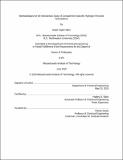| dc.contributor.advisor | Hadley D. Sikes. | en_US |
| dc.contributor.author | Stein, Kassi Taylor. | en_US |
| dc.contributor.other | Massachusetts Institute of Technology. Department of Chemical Engineering. | en_US |
| dc.date.accessioned | 2019-11-12T18:12:51Z | |
| dc.date.available | 2019-11-12T18:12:51Z | |
| dc.date.copyright | 2019 | en_US |
| dc.date.issued | 2019 | en_US |
| dc.identifier.uri | https://hdl.handle.net/1721.1/122906 | |
| dc.description | This electronic version was submitted by the student author. The certified thesis is available in the Institute Archives and Special Collections. | en_US |
| dc.description | Thesis: Ph. D., Massachusetts Institute of Technology, Department of Chemical Engineering, 2019 | en_US |
| dc.description | Cataloged from student-submitted PDF version of thesis. | en_US |
| dc.description | Includes bibliographical references. | en_US |
| dc.description.abstract | Reactive oxygen species (ROS) are an interesting class of molecules because of their ability to promote contradictory phenotypes depending on their intracellular concentration. Most significantly, their elevation has been linked with several pathologies, including cancer. The selective cancer killing hypothesis hinges on the idea that certain cancers will be more susceptible to toxicity via a redox-based mechanism than their surrounding healthy counterparts, and provides an attractive target for those studying redox biology. In order to effectively leverage this strategy, quantitative knowledge of intracellular ROS, specifically hydrogen peroxide (H₂O₂) and its associated pathway proteins, is necessary. This thesis developed tools and methodology for quantitative and mechanistic studies of H₂O₂ in the mitochondria. | en_US |
| dc.description.abstract | Both experimental and computational tools were developed and implemented to analyze mitochondrial H₂O₂, peroxiredoxin (Prx) proteins, and primary patient tumor cells. It was established that the toxicity of H₂O₂ perturbations localized to the mitochondrial matrix is dose- and time-dependent. A computational model of the mitochondrial H₂O₂ reaction network predicted that basal steady-state mitochondrial H₂O₂ concentrations are in the low nM range, and that Prx3 is responsible for H₂O₂ dynamics. Preliminary data in primary patient tumor cells of paraganglioma and related tumors with succinate dehydrogenase b (SDHB) mutations suggested these cancers are potentially sensitive to the investigational chemotherapeutic piperlongumine. | en_US |
| dc.description.abstract | And finally, analysis on the Prx family using statistical coupling analysis suggested evolutionarily conserved clusters of residues at the C-terminus of the Prx2 and Prx1 protein families that may point to a structure-function mechanism for their ability to complex with other proteins. All in all, these tools can be used in other cancer cell systems to better understand the quantitative H₂O₂ signaling mechanisms and possible chemotherapeutic targets within those pathways. | en_US |
| dc.description.statementofresponsibility | by Kassi Taylor Stein. | en_US |
| dc.format.extent | 157 pages | en_US |
| dc.language.iso | eng | en_US |
| dc.publisher | Massachusetts Institute of Technology | en_US |
| dc.rights | MIT theses are protected by copyright. They may be viewed, downloaded, or printed from this source but further reproduction or distribution in any format is prohibited without written permission. | en_US |
| dc.rights.uri | http://dspace.mit.edu/handle/1721.1/7582 | en_US |
| dc.subject | Chemical Engineering. | en_US |
| dc.title | Methodologies for the mechanistic study of compartment-specific hydrogen peroxide perturbations | en_US |
| dc.type | Thesis | en_US |
| dc.description.degree | Ph. D. | en_US |
| dc.contributor.department | Massachusetts Institute of Technology. Department of Chemical Engineering | en_US |
| dc.identifier.oclc | 1126284185 | en_US |
| dc.description.collection | Ph.D. Massachusetts Institute of Technology, Department of Chemical Engineering | en_US |
| dspace.imported | 2019-11-12T18:12:51Z | en_US |
| mit.thesis.degree | Doctoral | en_US |
| mit.thesis.department | ChemEng | en_US |
